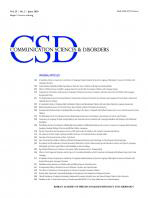- 영문명
- Phonological Representation across Subtypes of Children with Speech Sound Disorders
- 발행기관
- 한국언어청각임상학회
- 저자명
- 방하정(Hajeong Bang) 하승희(Seunghee Ha)
- 간행물 정보
- 『Communication Sciences & Disorders』vol30. no.3, 507~519쪽, 전체 13쪽
- 주제분류
- 사회과학 > 교육학
- 파일형태
- 발행일자
- 2025.09.30

국문 초록
배경 및 목적: 본 연구에서는 일반 아동과 말소리장애 아동, 그리고 말소리장애 하위유형 간 음운표상 수행력을 비교하여 말소리 오류와 음운표상의 관계를 분석하였다. 방법: 말소리장애 아동 26명과 일반 아동 26명 총 52명을 대상으로 음운표상 판단 과제와 무의미 낱말 따라말하기 과제를 실시하여 집단 간 수행력을 살펴보았다. 음운표상 판단 과제에서는 아동에게 실제 낱말과, 자음 또는 모음을 1-2 개 변별자질 수준에서 조작하여 만든 무의미 낱말을 함께 제시하고, 각 자극어가 실제 낱말인지 아닌지를 판단하도록 하였다. 이를 통해 아동이 자신의 내적 음운표상을 얼마나 정확하게 활용하는지를 평가하고, 자음·모음 조작 조건에 따른 수행력 차이를 분석하였다. 또한 무의미 낱말 따라말하기 과제에서는 음운 정확도와 낱말 정확도를 비교하였다. 말소리장애 아동은 표면 오류에 따라 조음장애, 음운지연, 음운장애의 하위유형으로 분류한 뒤 동일한 방식으로 비교하였다. 결과: 말소리장애 아동은 일반 아동에 비해 음운표상 판단 과제 수행력이 유의하게 낮았으며, 자음보다 모음 조작, 변별자질 1개보다 2개 조작에서 수행력이 유의하게 좋았다. 하위집단 간 비교에서는 조음장애 집단이 음운지연 및 음운장애 집단보다 음운표상 판단 과제에서 유의하게 높은 수행력을 보였다. 무의미 낱말 따라말하기과제에서도 말소리장애 아동의 낱말 및 음운 정확도가 일반 아동보다 낮았으며, 하위집단 간 비교에서는 음운장애 집단의 음운 정확도가 조음장애 및 음운지연 집단에 비해 유의하게 낮았다. 논의 및 결론: 말소리장애 아동은 일반 아동에 비해 음운표상 수행력이 낮았으며, 하위유형 간 비교에서도 조음장애 아동이 음운지연 및 음운장애 아동보다 유의하게 높은 수행력을 보였다. 본 연구결과는 말소리 오류가 음운표상의 결함과 밀접하게 관련되어 있음을 시사하며, 하위유형별 특성을 고려한 차별화된 중재 전략의 필요성을 뒷받침한다.
영문 초록
Objectives: This study aimed to investigate the relationship between speech sound errors and phonological representations by comparing the performance of typically developing (TD) children and children with speech sound disorders (SSD), and among the subtypes of SSD. Methods: The study involved 52 children, including 26 children with SSD and 26 TD children. Two experimental tasks were administered to examine group differences in performance: a phonological representation judgment task and a nonword repetition task. The phonological representation task consisted of varying consonant/vowel manipulations and feature contrasts. The nonword repetition task was used to compare phonological accuracy and word accuracy. Children with SSD were further classified into articulation disorder, phonological delay, and phonological disorder subgroups based on surface speech error patterns. Results: Children with SSD performed significantly lower than TD children on the phonological representation judgment task. Performance was higher in the vowel and multiple-feature conditions. Subgroup comparisons revealed that children with articulation disorders outperformed those with phonological delays and phonological disorders. In the nonword repetition task, children with SSD showed lower phonological accuracy and word accuracy than TD children, with the phonological disorder group demonstrating significantly lower phonological accuracy than both the articulation and phonological delay groups. Conclusion: The study confirms that children with SSD exhibit lower performance in phonological representation tasks compared to TD peers. It further suggests that articulation disorders are associated with relatively stronger phonological skills than either phonological delays or phonological disorders. These findings highlight that speech sound errors are closely linked to deficits in phonological representations and support the need for targeted interventions by subtype.
목차
연구방법
연구결과
논의 및 결론
REFERENCES
키워드
해당간행물 수록 논문
참고문헌
최근 이용한 논문
교보eBook 첫 방문을 환영 합니다!

신규가입 혜택 지급이 완료 되었습니다.
바로 사용 가능한 교보e캐시 1,000원 (유효기간 7일)
지금 바로 교보eBook의 다양한 콘텐츠를 이용해 보세요!


